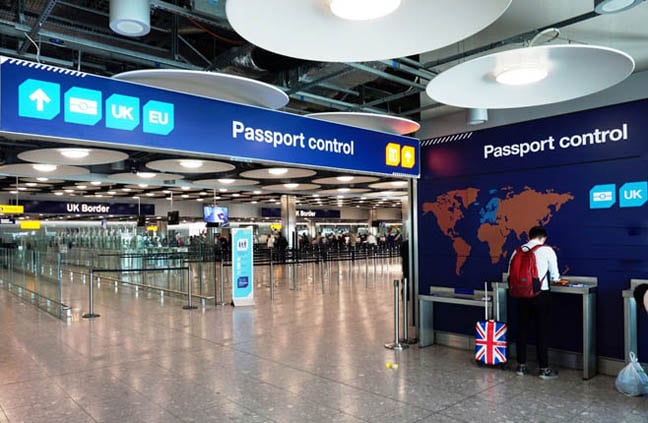The Home Office Will Need To Overturn A Long Legacy Of Failure To Achieve Ambition Of All-digital Border By 2025

The UK’s home secretary Priti Patel has claimed the UK borders will become “fully digital” by the end of 2025, with a raft of new technology schemes which critics might be tempted to characterise as wishful thinking.
In the hope of accurately measuring immigration for the first time, the launch of the new plans come just two months after MPs revealed the current UK digital border system, which was delayed by more than a year, was only stable enough to be used by 4 per cent of intended users.
In the Home Office paper launched today, the department said it would introduce a universal "permission to travel" requirement supported by an Electronic Travel Authorisation (ETA) scheme, which it said would be “fully in place by the end of 2024”, and be able to process up to 30 million applications per year.
“The ETA scheme will enable the government to conduct security checks on passengers and make more informed decisions on information obtained at an earlier stage, as to whether individuals should be allowed to travel to the UK,” the paper said.
To enable the new system, the department promised it was “improving critical infrastructure to support a range of [its] systems, and those of key security partners, law enforcement and other government departments”.
The Home Office said it is working with travel organisations “to deliver a fully digital end-to-end system” which would replace physical documents needed to prove travellers are eligible to enter the UK.
“We intend to provide that information directly to the carriers in digital format, but this requires partnership working and strong engagement to ensure it is deliverable by 2024,” the policy documents said.
Promising to smooth the flow of border entries using digital automation, the Home Office said individuals with an electronic permission would not need to show physical proof.
“Our intention is to significantly increase the use of automation, in particular ensuring that the majority of all arrivals to the main UK ports will pass through some form of contactless corridor or automated gates for identity and security checks,” the department said.
The strategy document also said the government plans to develop “identity solutions” to allow it to capture a person’s biographic and biometric identity just once, and as early as possible, in “new, unobtrusive ways.”
Putting aside the broader implications for civil liberties and the refugee process, the department clearly is not about to let its long experience of difficulties in introducing computer systems to manage border control stop it setting ambitious timetables for new, as yet ill-defined, systems.
- Delayed UK digital border system was only stable enough to be used by 4% of intended users, MPs say
- Seagate UK customer stung by VAT on replacement drive shipped via the Netherlands
- Delay upgrading the UK's legacy border systems has added £336m to taxpayers' bill
- It may date back to 1994 but there's no end in sight for the UK's Chief customs system as Brexit rules beckon
- With less than two months left, let's check in on Brexit: All IT systems are up and running and ready to go, says no one
Parliamentary spending watchdog the Public Accounts Committee found in March that the current Digital Services at the Border (DSAB) programme, which was supposed to go live in March 2019, would not be delivered until 2022, a delay costing £173m.
The Home Office had to suspend the Border Crossing pilot system in March 2020 because it was not stable enough and was only available to frontline staff included in the pilot for 54 per cent of the days it was in operation, the report found.
The Home Office started the DSAB programme in 2014 with a budget of £199m as the intended replacement for e-Borders, a project it abandoned following the termination of its £750m contract with the main supplier, Raytheon, in 2010. At one point it was set to cost £1bn and come in a full eight years late.
In 2015, public spending watchdog the National Audit Office said the e-Borders project had failed to deliver value for money.
The latest ambition for an all-digital immigration system was in stark contrast to the most recent PAC report. It found the Home Office’s entire major project portfolio was rated Red, meaning that it was impossible for it to deliver all its programmes on time and on budget. Digital Services at the Border and Emergency Services Network were the biggest risks the MPs said. ®
From Chip War To Cloud War: The Next Frontier In Global Tech Competition
The global chip war, characterized by intense competition among nations and corporations for supremacy in semiconductor ... Read more
The High Stakes Of Tech Regulation: Security Risks And Market Dynamics
The influence of tech giants in the global economy continues to grow, raising crucial questions about how to balance sec... Read more
The Tyranny Of Instagram Interiors: Why It's Time To Break Free From Algorithm-Driven Aesthetics
Instagram has become a dominant force in shaping interior design trends, offering a seemingly endless stream of inspirat... Read more
The Data Crunch In AI: Strategies For Sustainability
Exploring solutions to the imminent exhaustion of internet data for AI training.As the artificial intelligence (AI) indu... Read more
Google Abandons Four-Year Effort To Remove Cookies From Chrome Browser
After four years of dedicated effort, Google has decided to abandon its plan to remove third-party cookies from its Chro... Read more
LinkedIn Embraces AI And Gamification To Drive User Engagement And Revenue
In an effort to tackle slowing revenue growth and enhance user engagement, LinkedIn is turning to artificial intelligenc... Read more

